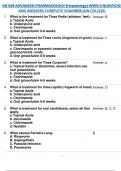Undecylenic acid - Study guides, Class notes & Summaries
Looking for the best study guides, study notes and summaries about Undecylenic acid? On this page you'll find 7 study documents about Undecylenic acid.
All 7 results
Sort by
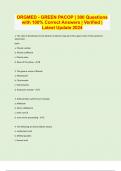
-
ORGMED - GREEN PACOP | 300 Questions with 100% Correct Answers | Verified | Latest Update 2024
- Exam (elaborations) • 69 pages • 2024
- Available in package deal
-
- $15.49
- + learn more
1. The ratio of disinfectant to the dilution of phenol required to kill a given strain of the bacterium Salmonella typhi: a. Phenol number b. Phenol coefficient c. Phenol value d. None of the above - B 2. The generic name of Nizoral: a. Meconazole b. Clotrimazole c. Ketoconazole d. Potassium sorbate - C 3. Sulfonamides used for burn therapy: a. Mafenide b. Silver sulfadiazine c. both a and b d. none of the preceeding - C 4. The following are preservatives except: a. undecylenic...
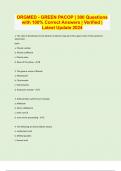
-
ORGMED - GREEN PACOP | 300 Questions with 100% Correct Answers | Verified | Latest Update 2024 | 69 Pages
- Exam (elaborations) • 69 pages • 2023
-
- $23.49
- + learn more
1. The ratio of disinfectant to the dilution of phenol required to kill a given strain of the bacterium Salmonella typhi: a. Phenol number b. Phenol coefficient c. Phenol value d. None of the above - B 2. The generic name of Nizoral: a. Meconazole b. Clotrimazole c. Ketoconazole d. Potassium sorbate - C 3. Sulfonamides used for burn therapy: a. Mafenide b. Silver sulfadiazine c. both a and b d. none of the preceeding - C 4. The following are preservatives except: a. undecylenic...
NR 568 ADVANCED PHARMACOLOGY (Hepatology) WEEK 3 QUESTIONS AND ANSWERS COMPLETE CHAMBERLAIN COLLEGE.

-
LPC 68W ALC Phase 3 Exam Questions With Correct Answers
- Exam (elaborations) • 29 pages • 2023
- Available in package deal
-
- $10.99
- + learn more
pharmacology - Answer study of substances that interact with living organisms through chemical processes medical pharmacology - Answer science of substances used to prevent, diagnose and treat disease indication - Answer reason or condition for which a particular medication is given dose - Answer amount of medication given within a specified period of time single dose - Answer amount of medication administered at one time maximum dose - Answer the largest amount of medication eith...
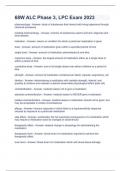
-
68W ALC Phase 3, LPC Exam 2023
- Exam (elaborations) • 21 pages • 2023
- Available in package deal
-
- $14.49
- + learn more
pharmacology - Answer- study of substances that interact with living organisms through chemical processes medical pharmacology - Answer- science of substances used to prevent, diagnose and treat disease indication - Answer- reason or condition for which a particular medication is given dose - Answer- amount of medication given within a specified period of time single dose - Answer- amount of medication administered at one time maximum dose - Answer- the largest amount of medicatio...
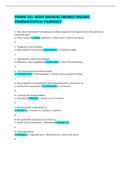
-
PHARM 101: MOD1 (MANOR) ORGMED ORGANIC PHARMACEUTICAL PHARMACY
- Exam (elaborations) • 16 pages • 2022
-
- $12.49
- + learn more
The ratio of disinfectant to the dilution of phenol required to kill a given strain of the bacterium Salmonella typhi: a. Phenol number b. Phenol coefficient c. Phenol value d. None of the above 2. The generic name of Nizoral: a. Meconazole b. Clotrimazole c. Ketoconazole d. Potassium sorbate 3. Sulfonamides used for burn therapy: a. Mafenide b. Silver sulfadiazine c. both a and b d. none of the preceeding 4. The following are preservatives except: a. undecylenic acid b. Methyl para...

-
Organic Medicinal Chemistry Q&A
- Exam (elaborations) • 18 pages • 2022
-
- $11.99
- + learn more
PACOP REVIEWER (2017) Organic Medicinal Chemistry MULTIPLE CHOICE 1. Decarboxylation of L-dihydroxyphenylalanine produces A. Tyrosine D. Dopamine B. Epinephrine E. Norepinephrine C. Ephedrine ANS: D 2. Drugs with superior lipid solubility usually possess what moiety A. Oxygen D. Sulfur B. Nitrogen E. Fluorine C. Chlorine ANS: D 3. The compound that reacts to salicylic acid to make aspirin is an example of a(n) A. Alcohol D. Acid anhydride B. Ketone E. Ester C. Ether ANS: D 4. T...

That summary you just bought made someone very happy. Also get paid weekly? Sell your study resources on Stuvia! Discover all about earning on Stuvia

